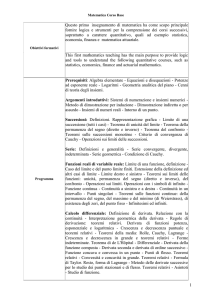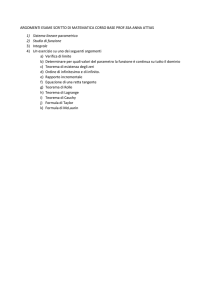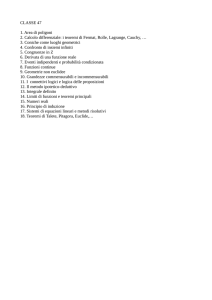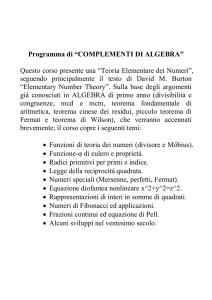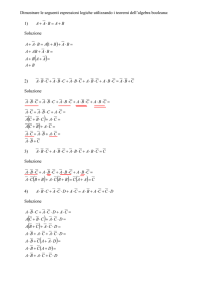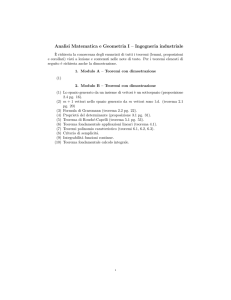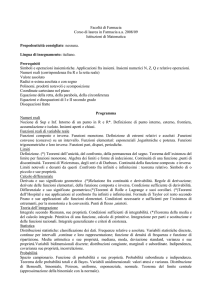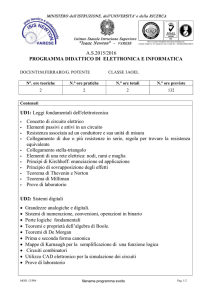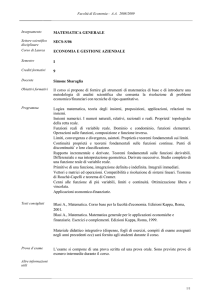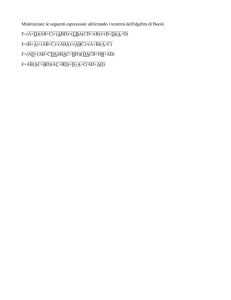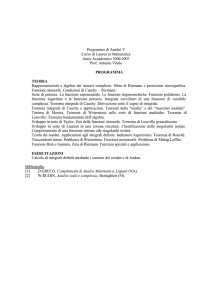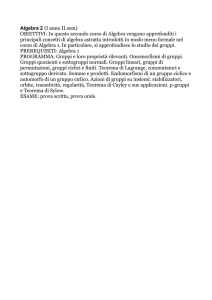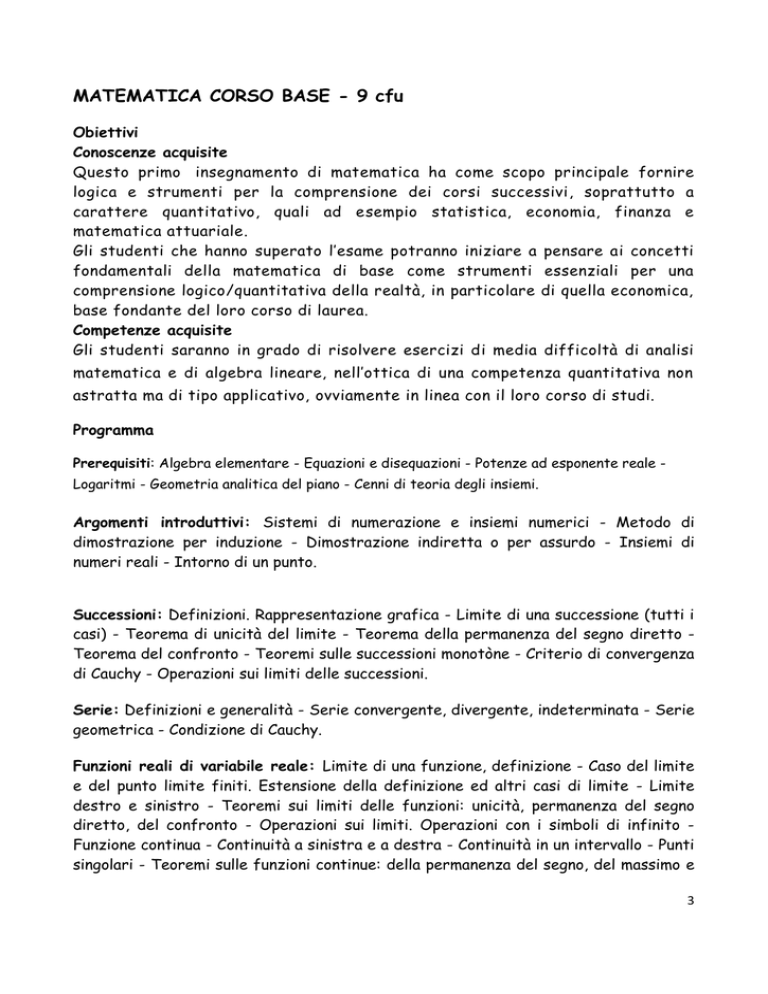
MATEMATICA CORSO BASE - 9 cfu
Obiettivi
Conoscenze acquisite
Questo primo insegnamento di matematica ha come scopo principale fornire
logica e strumenti per la comprensione dei corsi successivi, soprattutto a
carattere quantitativo, quali ad esempio statistica, economia, finanza e
matematica attuariale.
Gli studenti che hanno superato l’esame potranno iniziare a pensare ai concetti
fondamentali della matematica di base come strumenti essenziali per una
comprensione logico/quantitativa della realtà, in particolare di quella economica,
base fondante del loro corso di laurea.
Competenze acquisite
Gli studenti saranno in grado di risolvere esercizi di media difficoltà di analisi
matematica e di algebra lineare, nell’ottica di una competenza quantitativa non
astratta ma di tipo applicativo, ovviamente in linea con il loro corso di studi.
Programma
Prerequisiti: Algebra elementare - Equazioni e disequazioni - Potenze ad esponente reale Logaritmi - Geometria analitica del piano - Cenni di teoria degli insiemi.
Argomenti introduttivi: Sistemi di numerazione e insiemi numerici - Metodo di
dimostrazione per induzione - Dimostrazione indiretta o per assurdo - Insiemi di
numeri reali - Intorno di un punto.
Successioni: Definizioni. Rappresentazione grafica - Limite di una successione (tutti i
casi) - Teorema di unicità del limite - Teorema della permanenza del segno diretto Teorema del confronto - Teoremi sulle successioni monotòne - Criterio di convergenza
di Cauchy - Operazioni sui limiti delle successioni.
Serie: Definizioni e generalità - Serie convergente, divergente, indeterminata - Serie
geometrica - Condizione di Cauchy.
Funzioni reali di variabile reale: Limite di una funzione, definizione - Caso del limite
e del punto limite finiti. Estensione della definizione ed altri casi di limite - Limite
destro e sinistro - Teoremi sui limiti delle funzioni: unicità, permanenza del segno
diretto, del confronto - Operazioni sui limiti. Operazioni con i simboli di infinito Funzione continua - Continuità a sinistra e a destra - Continuità in un intervallo - Punti
singolari - Teoremi sulle funzioni continue: della permanenza del segno, del massimo e
3
del minimo (di Weierstrass), di esistenza degli zeri, del punto fisso - Funzione
composta e funzione inversa - Infinitesimi ed infiniti.
Calcolo differenziale: Definizione di derivata. Relazione con la continuità Interpretazione geometrica della derivata - Regole di derivazione: teoremi relativi.
Derivata di funzioni potenza, esponenziale e logaritmica - Crescenza e decrescenza
puntuale e teoremi relativi - Teoremi della media: Rolle, Cauchy, Lagrange - Crescenza
e decrescenza in grande e teoremi relativi - Forme indeterminate. Teorema di de
L'Hôpital - Differenziale - Derivata della funzione composta e teorema relativo Derivata della funzione inversa e teorema relativo - Derivata seconda e derivata di
ordine successivo - Funzione concava e convessa in un punto - Punti di flesso. Teoremi
relativi - Convessità e concavità in grande. Teoremi relativi - Formula di Taylor. Resto,
forma di Lagrange - Metodo delle derivate successive per lo studio dei punti
stazionari e di flesso. Teoremi relativi - Asintoti - Studio di funzione.
Calcolo integrale: Somme integrali, definizione di integrale e teoremi relativi Integrale: significato geometrico. Proprietà - Teorema del valore medio - Integrale
definito. Teoremi relativi - Funzione integrale - Teorema fondamentale del calcolo
integrale - Calcolo dell'integrale definito mediante la primitiva - Integrali indefiniti Metodi di integrazione indefinita: per scomposizione, per trasformazione, per
sostituzione, per parti - Regola per il calcolo degli integrali definiti - Integrazione per
scomposizione, per sostituzione e per parti.
Algebra lineare: Vettori - Operazioni con i vettori - Combinazione lineare di vettori Combinazione lineare convessa di vettori - Spazi e sottospazi vettoriali - Dipendenza
ed indipendenza lineare. Teoremi relativi - Rango di un insieme di vettori - Sistema di
generatori di uno spazio vettoriale. Base - Teorema di rappresentazione unica Teorema fondamentale degli spazi lineari - Matrici - Operazioni con matrici e
proprietà - Determinante di una matrice - Calcolo dei determinanti. Regola di Sarrus.
Primo teorema di Laplace - Minori di una matrice - Caratteristica di una matrice Teorema di Kronecker - Proprietà dei determinanti - Sistemi di equazioni lineari Risoluzione di un sistema di equazioni lineari. Teorema di Rouché-Capelli. Teorema di
Cramer -Sistemi lineari omogenei - Sistemi lineari parametrici – Autovalori e
autovettori.
Funzioni reali di due e più variabili reali (cenni): domini, limiti, continuità, derivate
4
parziali e teorema di Schwarz, funzioni omogenee e teorema di Eulero, massimi e
minimi liberi, massimi e minimi vincolati con il metodo dei moltiplicatori di Lagrange.
Testi:
M. Angrisani, Introduzione alla attività matematica, CISU Edizioni, Roma, 2011;
A. Attias - P. Ferroni, Introduzione alla attività matematica, 700 esercizi
svolti, CISU Edizioni, Roma, 2012;
S. Bianchi, Appunti di Algebra lineare (dispense disponibili all'indirizzo:
http://mat.eco.unicas.it);
Appunti distribuiti durante il corso.
5
MATHEMATICS – BASIC COURSE (MATEMATICA CORSO BASE) 9 cfu
Goals
Acquired knowledge
This first mathematics teaching has the main purpose to provide logic and tools
to understand the following quantitative courses, such as statistics, economics,
finance and actuarial mathematics.
Students who have passed the examination will be able to think about th e
fundamental concepts of basic mathematics as essential tool for a
logic/quantitative uptake of reality, especially the economic one, fundamental
basis of their degree course.
Acquired skills
Students who have passed the examination will be able to solve medium
difficulty exercises concerning mathematical analysis and linear algebra in a
view of a quantitative skills, which should be applicative and not abstract, and
this obviously in line with their couse of study.
Program
Prerequisites: basic algebra - equations and inequations - exponentiation with real
exponent – logarithms - analytic geometry - set theory.
Outline: numeration systems and numerical sets - induction-proof method - indirect
proof (argument's sake) - sets of real numbers - neighborhood of a point.
Sequences: Definitions - Graphic representation – Limit of a sequence (all cases) uniqueness of the limit - sign-persistence direct Theorem - comparison theorem theorems on monotone sequences - Cauchy's convergence criterion (demonstration of
necessary condition only) - operations on limits of sequences.
Series: General definitions - Convergent, divergent, indeterminate series - Geometric
series and harmonic series - Cauchy's condition.
Real valued function of a real variable: Limit of a function - Case of finite limit and
finite limit-point - Generalization of the definition and other limit cases - Right and
left limit - Theorems on limits of functions: uniqueness - Sign-persistence direct
Theorem, of comparison - Operations on limits - Operations with infinitives symbols Continuous functions - Continuity on right and on left - Continuity on an interval Singular points - Theorems on continuous functions: sign-persistence, of the maximum
8
and the minimum (Weierstrass's theorem), of existence of zeros, of fixed point Compound function and inverse function - Infinitesimals and infinitives - Remarkable
limits.
Differential calculus: Definition of derivative - Relation with the continuity Geometric interpretation of derivative - Rules of derivation: related theorems Derivative of power, exponential and logarithmic functions - Locally increasingly and
decreasingly function and related theorems - Theorem of mean: Rolle, Cauchy,
Lagrange - Globally increasingly and decreasingly function and related theorems Indeterminate forms - de l'Hôpital's theorem - Differential of a function Derivative of compound function - Derivative of inverse function - Second derivative
and higher order of derivatives - Locally concave and convex function - Points of
inflection and related theorems - Concave and convex function in an interval and
related theorems - Taylor’s formula - Lagrange form for the remainder in Taylor’s
formula - Derivatives method to study stationary and points of inflections and
related theorems – Asymptotes - Graphical representation of a function.
Integral calculus: Integral sums, definition of integral and associated theorems Integrals as an area - Proprieties of the integral - The mean value theorem for
integrals - Definite integral and related theorems - Integral function - Fundamental
theorem of integral calculus (Torricelli and Barrow’s theorem) - Use of the primitive
function for evaluation of the definite integral - Indefinite integral - Indefinite
integration methods: by decomposition, by substitution and by parts - Rules for
evaluation of definite integrals - Definite integration methods: integration by
decomposition, by substitution and by parts.
Linear algebra: Vectors - Algebra with vectors - Linear combination of vectors Convex linear combination of vectors - Linear spaces and subspaces - Linear
dependence and independence and related theorems - Rank of a vector set Generator set of a linear space - Basis of a linear space - Theorem of unique
representation - Fundamental theorem of linear spaces – Matrices - Algebra with
matrices – Determinants - Evaluation of determinants - Sarrus’s rule - First Laplace’s
theorem - Minors of a matrix - Rank of a matrix - Kronecker’s theorem - Properties
of determinants - Systems of linear equations - Solution of a system of linear
equations - Rouché-Capelli’s theorem - Cramer’s theorem - Homogeneous systems of
linear equations - Parametric systems of linear equations – Eigenvalues and
eigenvectors.
9
Real valued function of two and more real variable (signs): domains - limits –
continuity – partial derivative and Schwarz theorem – homogeneous functions and
Eulero’s theorem – free maxima and minima - Hint on constrained maximization and
minimization with Lagrange multipliers.
Texts
M. Angrisani, Introduzione alla attività matematica, CISU Edizioni, Roma, 2011;
A. Attias - P. Ferroni, Introduzione alla attività matematica: 700 esercizi
svolti, CISU Edizioni, Roma, 2012;
S. Bianchi, Appunti di Algebra lineare (at the address: http://mat.eco.unicas.it);
Notes distributed to students directly.
10

